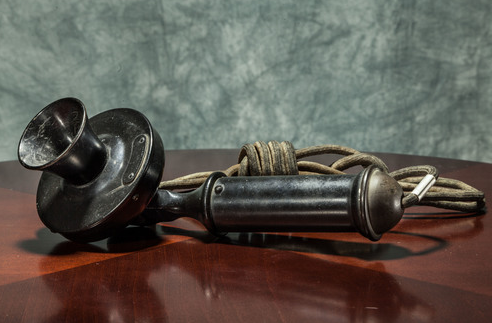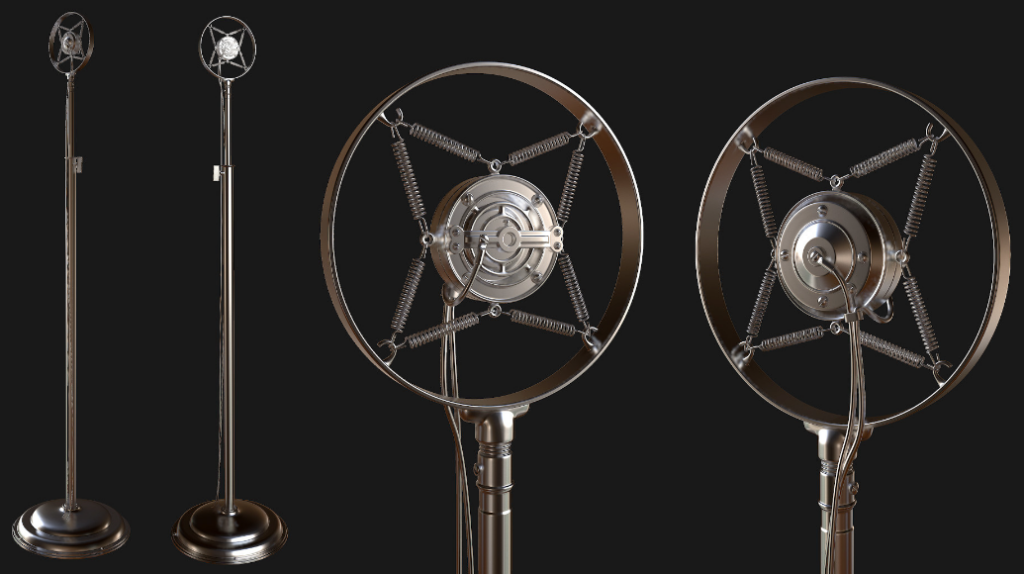If you think condenser or dynamic microphones are the first-ever manufactured devices for capturing audio, think twice! Because carbon microphones were the initial invention that changed the entire audio industry. But since they are not widely popular at this present time, there is not enough information available about them.
So, if you are interested to know how carbon microphones were invented, who are the real inventors, and how they work? This article can help in increasing your knowledge about carbon mics. You will also learn about their main components, and applications, and find answers to some of the most frequently asked questions about these microphones.
History of Carbon Microphones

The history of a carbon microphone has many directions, leading to multiple inventors claiming this invention. It all began when the world was only known to the Liquid Transmitter, also called the ‘Water Microphone.’ This device used water as the main component that acted as a medium to transfer audio signals. But it all changed with the advent of a carbon microphone. Carbon mics revolutionized the entire communication standards. It was the first microphone that could truly provide clean audio transmission at that time.
However, there are different inventors, who believe, have the right to acclaim this invention. Maybe because the carbon microphone innovation was held in multiple parts of the world in the late 1800s. Famous names like Thoman Edison (United States), Emile Berliner (German-American inventor), and David Edward Huges from England, can be considered as the key players for inventing a carbon microphone. Since each of them has their own story to claim, some sources of history credit one person others put the crown over another’s head. Nevertheless, they all helped shape different designs of carbon microphones, as you can see in these images.


Although Edison received the first patent in mid-1877 for a device that appeared similar to a carbon microphone, Hughes already demonstrated the functioning version of these microphones several years ago before Edison’s demand for the patent. The Hughes version used loosely compact carbon granules. When the sound waves caused pressure on these granules, they produced electrical sound signals. Hughes also presented this invention to the Royal Society. However, he was never serious about obtaining the patent rights. Instead, he preferred his invention as a gift to the world.
But where Hughes showed generosity, a legal dispute between Berliner and Edison occurred in the US for the patent rights. At last, Edison won the dispute and the federal court gave him full rights for inventing carbon microphones. However, according to a few other historical sources, the patent rights were awarded to Berliner. Later, Alexander Graham Bell acquired all the rights from him for $50,000.
Regardless of the confusion about who was the real inventor of carbon microphones, this new device painted a whole different world. The microphone was taken as the main inspiration for designing modern-day microphones and played a major role in the broadcasting, telephony, and sound recording industries. In the early models, carbon microphones used a platinum bead suppressed against a solid carbon disc, and then came the carbon granules version. More advancements were made in the design of this microphone over the years.
How Do Carbon Microphones Work?

The Radio-Craft Maganize explained the functionality of carbon microphones back in 1938.
These microphones rely on the varying pressures that change the carbon resistance. Generally, this microphone’s diaphragm consists of two carbon buttons on each side to offer regeneration of high-quality audio. The diaphragm is carefully designed in such a way that it is air-damped and stretched to reduce the vibration effect for providing a constant sound output in various audio frequencies.
To understand more simply, imagine a small hollow circle. In that circle lie carbon granules covered with a delicate metal diaphragm. This structure requires an external power source in order to flow current in all of the microphone’s components to make it functional.
When the subject speaks into the mic, the sound waves meet the diaphragm, causing vibrations. These vibrations put a certain pressure on the carbon granules, which modifies the granules’ resistance, impacting the current that is circulating throughout the components.
The mechanism is quite straightforward, resulting in a reliable and powerful microphone. But it is a bit noisier mic compared to modern microphones. Moreover, there are also some limitations to carbon microphones. For instance, it has a narrow frequency response range. It produces a noticeable electrical noise. Sometimes, you may experience crackling sounds that can be resolved by tapping the mic gently, as it compels carbon granules to get back to the firm position for stable current flow.
Main Components of a Carbon Microphone

Here are the four essential components of carbon microphones, giving them their unique shape, design, and functionality.
a. Diaphragm
The diaphragm in a carbon microphone is either made of a thin plastic or metal. It is flexible in nature, allowing it to react to the vibrations of the sound waves but robust enough for regular use.
The diaphragm serves as a core membrane of the mic for capturing and converting audio vibrations into mechanical vibrations, compressing carbon granules. For example, when someone talks into a carbon mic, their voice vibrates the diaphragm. This component is like the microphone’s ear, serving as a middleman and aiding the transformation of audio waves into electrical signals.
b. Carbon Granules
Carbon microphones consist of small carbon particles packed together called carbon granules. These granules are composed of graphite or carbon powder, making them great electricity conductors. These are the most essential components as they control the sensitivity of carbon microphones to sound waves.
When these granules interact with sound, they either compress or decompress themselves, turning the sound waves into electrical signals for transmission and amplification through their resistance capability. For example, in the early days of the telephone era, carbon granules permitted long-distance communication due to their ability to convert audio into electrical signals.
c. Electrodes
There are small conductive plates called electrodes in a carbon microphone that rests beside each other. Electrodes link the main carbon granule chamber to the outer circuit of the microphone. They also play a vital role in transforming audio waves into electrical signals.
These electrodes alter in distance as soon as the sound hits the mic, modifying electrical resistance among them. As a result, an electrical current is generated that contributes to the final sound output (the voice you hear through the microphone).
To understand how electrodes work, imagine how each piano key sounds differently when pressed one by one. Therefore, in this scenario, carbon granules act like the piano keys. Whereas the electrodes serve as the sensors that identify each key press.
d. Housing
Housing is like a cozy home for the carbon microphone’s components. This is where the essential parts remain firm. The primary purpose of housing is to keep everything inside a carbon microphone safe so that it works well in capturing the audio. Think of this component as a protective shell. But at the same time, it also helps reduce environmental noise while allowing the microphone to focus on the main sound.
Advantages and Disadvantages of Carbon Microphones

Here are some of the most important strengths and weaknesses of a carbon microphone.
Pros of a Carbon Microphone
- Due to low manufacturing costs, these are inexpensive microphones than other types
- Carbon microphones have a simple and uncomplex design yet they are strong enough to withstand harsh handling
- The major advantage of a carbon microphone compared to other devices is that they can generate powerful audio signals and amplify sound from extremely low DC power without requiring additional batteries
Cons of a Carbon Microphone
- The random movement of carbon granules leads to hissing sounds and background noises
- Carbon microphones possess a limited frequency response range, resulting in lower sound quality than modern-day mics
- Despite the rugged design, these microphones are sensitive to moisture and may not work well in humid environments
Applications of Carbon Microphones
Uses of Carbon Microphones in the Past
In the past, carbon microphones were used in various environments, including:
Public Speech

Carbon microphones were once a star of the house when it came to public speeches. This mic has been a companion for many famous public speakers, including Martin Luther King Jr. Due to their sturdy manufacturing and ability to capture voices well, these microphones were once perfect for interacting with a large crowd.
Military Operations

Carbon microphones were compulsory military equipment back in the day. Soldiers and high-ranked personnel relied on these mics for communication during wars and battles. Word War II is a prime example of how carbon microphones served troops by delivering messages over long distances.
Broadcasting

Before new microphones came into existence, carbon mics were the whole and sole technology for television and radio broadcasts. They were widely used for AM broadcasting.
Telephony

If you have seen a vintage telephone with a big receiver and a transmitter, it means you have seen the utilization of carbon microphones in the telephony systems. These vintage telephones used to have carbon mics inside of them, and they proved to be great initial telephone technology.
Uses of Carbon Microphones in the Present
Although carbon microphones are not mainstream devices for capturing audio, they are still used in some cases. For instance:
Under Hazardous Environments

Since carbon microphones have durable construction, they are used in various industrial settings where there is a major risk of chemical exposure or explosions, as these mics can withstand unfriendly environments compared to most delicate, new-day microphones. They act as a reliable tool for communication for workers, ensuring that they stay safe and connected during their duty hours.
Educational Purpose
Some scientific educational organizations still utilize these microphones to teach students the basic principles of electricity and sound. This way, the students can learn methods to assemble electrical circuits with carbon microphones to learn how they can convert sound waves into electrical signals.
Maintenance and Troubleshooting of Carbon Microphones

It is necessary to maintain a carbon microphone to ensure it keeps functioning well. This requires some tasks that need to be performed daily or whenever required.
a. Regular Cleaning
The first task is cleaning. Cleaning a carbon mic regularly keeps it dirt and dust-free which can affect its overall working capability. To do that, you can use a soft brush or a piece of cloth to clean the external body of the microphone to remove any debris that may be gathered over time.
b. Replacing Carbon Granules
The next method is the replacement of carbon granules. Carbon granules are the main components of carbon microphones and with time, they can lose their effectiveness and wear out. You should look for the signs of contamination and ensure that the granules are not compacted because these indications reduce the mic’s ability to pick up sound.
Therefore, replacing them with new ones can help ensure that the microphone reproduces clear audio. Although carbon granule replacement is done occasionally, it plays a vital role in the microphone’s maintenance.
c. Check Diaphragm for Damage
One of the basic troubleshooting steps is to check the diaphragm of the carbon microphone for any damage. If it’s worn or broken, the microphone will not work.
d. Inspect Connections
Another essential area to check is the carbon microphone’s electrical connections. As time goes by, these connections become corroded, affecting the microphone’s functionality to transmit audio. So, make sure all the electrical components are corrosion-free for optimum performance.
e. Save them from Damp Atmosphere
If you are not using the carbon microphone, keep it in a safe, dry place, as extreme humidity is unsuitable for this microphone.
Conclusion
A carbon microphone is the reason you can find modern types of microphones. Although these mics may not even be close to the features offered by the latest devices, such as the Hollyland Lark M2, or other wireless or wired microphones, they can still be found in some industries. While multiple personalities claim to be the inventors of carbon microphones, it seems like everyone played their part in making these mics better over time. Today, carbon mics may not provide sufficient audio quality for professional audio recording, but they have played their role in providing a way for top-notch communication in the 1800s and 1900s.
While carbon microphones were an essential milestone in audio history, today’s wireless lavalier microphones deliver superior clarity and mobility. Modern wireless lavaliers offer convenience, reliability, and pristine sound quality – ideal upgrades to experience how far microphone technology has advanced.
Best Seller
Sale

Hollyland LARK M2S – Wireless Clip-on Microphone
- 7g Lightweight, Titanium Clip, Discreet Design
- Clear sound with 24-bit/48kHz, 70dB SNR, 116dB SPL
- Noise Cancellation & 300m Long-Range Stability
- Works with Camera/iPhone/Android/Laptop
- Perfect for Content Creators, Online-Teaching, Streaming
$139
$159
FAQs Related to Carbon Microphones
Q1. What makes carbon microphones different from other types of microphones?
Carbon microphones are different from other mic types as they have the unique characteristic of acting as an amplifier. It can use a small level of sound energy and increase it to control a higher amount of electrical power. One great example to prove this fact is remembering the early days when these mics were used as telephone systems, permitting people to communicate over long-distance calls. So, due to the amplifying power, these microphones have a history of connecting people like no other microphone type.
Q2. How do carbon microphones work?
When sound waves interact with the carbon mic’s diaphragm, it begins to move in a to and fro motion, just like a small drum responding to the sound rhythm. It hits and presses carbon granules inside the mic when it’s in motion. These granules, due to pressure changes caused by the audio waves, act by either expanding or compressing. This expansion and compression modifies the electricity flow within the microphone body, developing variations in the electrical current. Therefore, the conversion of the motion of the sound into electrical signals amplifies and transmits hearable audio.
Q3. Why are carbon microphones not widely used today?
There are a few reasons why carbon microphones are not a big part of the industry. The first drawback is its extremely limited frequency response. You cannot use them to capture a broad range of sounds, which negatively impacts the audio quality. The next reason can be the lack of adaptability. Carbon microphones have fewer features compared to the latest microphone types. For instance, condenser and dynamic microphones, which were invented after carbon mics, offered better performance and features, in both high and low price ranges. Most importantly, the new microphones have a high range of frequency response, making them convenient for different applications, especially studio recordings and live events.
Q4. Can a carbon microphone be used for professional audio recordings?
You may experiment with carbon microphones to record sound. However, experts don’t recommend that. These mics were designed for communication purposes; therefore, their capability for audio recording is pretty basic. Due to their inadequate support to a variety of frequencies, these microphones may not be the ideal choice for professional recording sessions. Nevertheless, in certain scenarios where you don’t need high-fidelity, carbon microphones can still be utilized. But, bear in mind that they may not accurately reproduce the full spectrum of audio frequencies. Moreover, these microphones also don’t have the latest features, such as level adjustments, noise-canceling, and more, necessary for modern-day recordings.
Q5. How can I make a carbon microphone at home?
Yes, you can make your own carbon microphone at home for fun. You will need graphite (the one found in the pencil will do the job), a small tin container, wood or thick material like cardboard for the base part, wires for electrical signals, and a battery. First, you will need to make a base by cutting the cardboard. Once done, place a tiny piece of graphite into the container. Next, connect the base and container with a circuit through electrical wires. You may need to power the microphone and test it by speaking into the diaphragm. But please be extra cautious in this entire process since it involves electricity.
Q6. Are carbon microphones sensitive to environmental conditions?
Carbon microphones are sensitive to humidity. They lose their performance capabilities under damp and moist environments. Therefore, it is always recommended to store them in dry places where there are no chances of water contact. Contrarily, these microphones can survive dry atmosphere, be it hot weather or a sunny day as these conditions don’t contribute to rust and corrosion, until exposed to extremely harsh substances, like radiation and chemicals.
Q7. How do I troubleshoot a carbon microphone that is not working?
You should understand the manufacturing of carbon microphones before troubleshooting them. Remember, the main component is the carbon in these mics. Sometimes, due to moisture, the carbon granules stop working. So, if you can dry the component that contains the carbon granules and shake it carefully, the mic may start working again. One of the best ways to dry carbon components is to keep them under the sunlight. It is also observed that sometimes simply tapping the diaphragm can fix a non-functional carbon microphone. Nevertheless, it is always good to take preventive measures and cover the mic with a thin plastic sheet when not in use.
Q8. What are some modern applications of carbon microphones?
The condenser, dynamic, and wireless lavalier microphones have superseded carbon microphones long ago due to their advantages and features. But, carbon mics are still used in antique telephone systems, which are usually kept as a showpiece at home. Moreover, these mics are also found in learning institutions to help students understand the relationship between sound and electricity. Unfortunately, carbon microphones are not utilized for professional studio recordings, streamings, or live performances due to restricted frequency response.
Q9. Can carbon microphones be connected to modern audio equipment?
There is no strong evidence of whether carbon microphones can be connected to audio interfaces and other latest equipment. But you can always try. However, even if the connectivity is technically possible, carbon mics may not provide high-quality sound due to the lack of frequency response, high impedance, and noise.
Q10. What were the key historical milestones in the development of carbon microphones?
According to several sources, Thomas Edison discovered that carbon can be used for transmitting and amplifying audio. Contrarily, David Edward Hughes improved the design of a carbon microphone by making loose contact between the carbon granules, which made the mic sound better. On the other hand, Emile Berliner took the design and incorporated it into a new device, giving the first-ever telephone transmitter, which revolutionized the telephony industry.
































.png)



